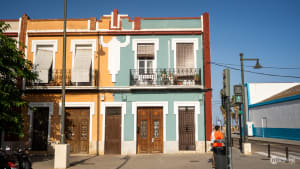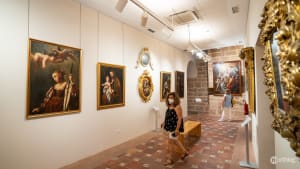
10 Must-visit Sights in Valencia
History, art, culture, relaxation, and beautiful views. Here are the ten sights you cannot miss when coming to Valencia.
10 must-visit sights in Valencia in a nutshell...
Valencia’s essential landmarks span from medieval treasures to futuristic marvels.
History lovers should explore the Gothic Lonja de la Seda (Silk Exchange), the Valencia Cathedral housing the Holy Grail and its panoramic Miguelete tower, the Torres de Serranos medieval gateway, the ornate San Nicolás Church (Spain’s “Sistine Chapel”), the grand Plaza del Ayuntamiento, and the Modernist Mercado Central where local culinary traditions come alive.
For a blend of nature, art and innovation, don’t miss Santiago Calatrava’s breathtaking City of Arts and Sciences complex with its science museum, planetarium and Europe’s largest aquarium.
Art enthusiasts shouldn’t miss the IVAM (Valencian Institute of Modern Art) with its thought-provoking exhibitions.
When seeking respite, the 10km Turia Park offers a green oasis running through the former riverbed, while Valencia’s pristine golden beaches provide the perfect Mediterranean escape with promenades, beach bars, and water activities.
The blue tiles of the church domes gleam in the warm sun as the bells toll. Down below is a cheerful chatter of people. The clinking of glasses heaping with colourful drinks and the plates full of aromatic foods fills the plazas. This is Valencia, one of the locations to enjoy the best weather in Spain. But that is not all the city has to offer.
Valencia can pride itself on all the architecture and history of an ancient merchant city, all the buzz and sparkle of a capital, and the light-hearted and laid-back energy that only a sunny seaside city can have. This palm-fringed gem is rich in cultural sights, historical monuments, green spaces, precious relics, and avant-garde art.
So where to start? You can begin with the essential sights, those that you cannot miss when visiting Valencia. Here are ten of them, the most visited and well-known venues and complexes in the city.
The menu we have prepared for you includes a bit of everything to indulge everyone’s taste: a few historical monuments balanced by some green parks, beautiful views over the city and some stunning churches. To finish off, golden beaches and a healthy amount of contemporary art.
City of Arts and Sciences
Ciudad de las Artes y las Ciencias is an avant-garde complex dedicated to science, culture, and the arts. This hyper-futuristic compound will make you feel like you just walked into the future. You will find yourself strolling on slender footbridges suspended over shallow and clear water pools. The gigantic, biomorphic architecture all around will tower over you.
The complex has become one of the city’s most recognisable landmarks. Your visit to Valencia is not complete if you miss this one.

This city of glass and white steel is made up of six structures: the space-ship-like Palau de les Arts Reina Sofía, the planetarium-cum-IMAX cinema Hemisfèric, the urban garden Umbracle, the Àgora exhibition centre, and Europe’s largest aquarium, the Oceanogràfic.
The complex is not only a recognised part of Valencia’s skyline but it is also designed by the internationally renowned architect Santiago Calatrava . His works are scattered worldwide, including places like Qatar, Sweden, Brazil, Belgium, and the US. However, the City of Arts and Sciences is his largest project to date.

Torres de Serranos
You’ll find this historical treasure in the Carmen neighbourhood, right in front of Turia Park. You can walk the same steps that millions of travellers have walked through the centuries, crossing the Serranos Bridge and passing under the Serranos Towers to enter the city.

Once part of the twelve entrance points along the city wall, this is today one of the only two remaining gateways, and the best preserved one at that.

The Serranos Towers are a must-see for anyone who wants to get an idea of mediaeval Valencia. Inside the towers, you’ll get to enjoy a unique blend of military and ceremonial Gothic architecture. Climbing to the top, you’ll have a beautiful panoramic view over the Turia Park and the city’s Old Town, the Ciutat Vella.
Catedral de Valencia and Miguelete
The Cathedral of Valencia (also called la Seu) is Valencia’s most important religious building and the place where you can find the Holy Grail, as recognised by the Roman Catholic Church.
In typical Valencian fashion, the church was built on an ancient mosque and remodelled several times, still retaining various elements in different styles. This means that at every corner you turn, you won’t know whether you’ll find Gothic, Baroque, Romanesque, or Neoclassical architecture.
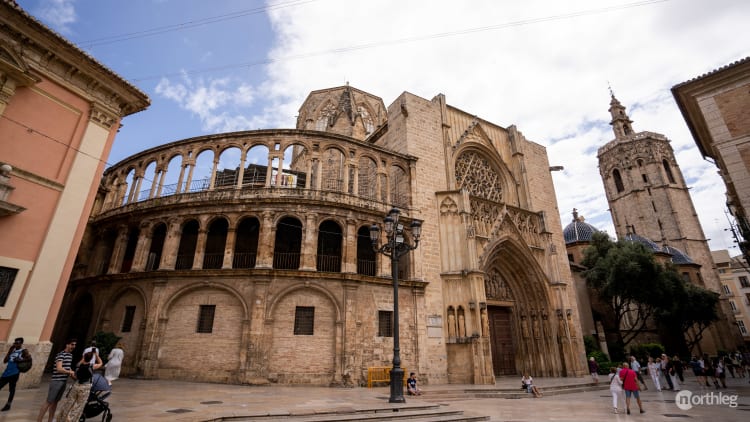
If all that wasn’t enough, the Cathedral also has an incredible underground museum with magnificent and precious artefacts, as well as a panoramic bell tower. This bell tower, the Miguelete, offers a spectacular view to those willing to climb its 207 steps. And if you’re lucky enough, you’ll get to see the city as the Cathedral’s 14 bells toll.
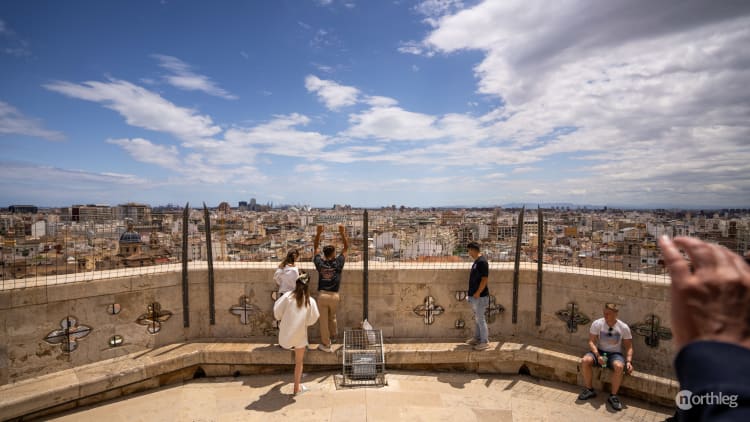
And don’t forget that just behind the Cathedral is Plaça de la Mare de Déu, (or Plaza de la Virgen), one of the most emblematic squares of the city. You can relax on the stone benches and enjoy the gurgling sound of the fountain and the view of the monuments around you.
Turia Park
This is the serpentine urban garden that hugs the city of Valencia, known as Jardín del Turia. The Turia Garden - almost 10 km long (about 6 miles) - snakes through the city providing a much-needed green respite. It is one of the most beloved and popular parks in the city.

In it, you’ll find leisure areas, fountains, footpaths, bike lanes, open-air gyms, and sports pitches. The park is a defining part of the city’s landscape and history. Anyone here can tell you how much Valencians care for the Turia - once a river, now turned into a public park.
Lonja de la Seda
This building too, is an essential for history and architecture lovers. The Lonja de la Seda (Silk Exchange, in English), is perhaps the most important example of Valencian civil Gothic style.

The building is a testament to the power and wealth held by Valencia in its Golden Age, when it had become one of the great Mediterranean mercantile cities. This structure is a triumph of elongated and evocative lines, intricate shapes and decorations, allegorical carvings and bas-reliefs.

Stepping into this building feels like walking into a high historical fantasy dream. Tall and painstakingly decorated coffered ceilings, pointed arches and mysterious, demonic stone figures populate the halls of this Valencian gem.
Mercado Central
Valencia, like the rest of Spain, is known for its many covered markets, and the Central Market is the crown jewel of this tradition. This is Europe’s biggest fresh produce market and one of the city’s most important modernist constructions.
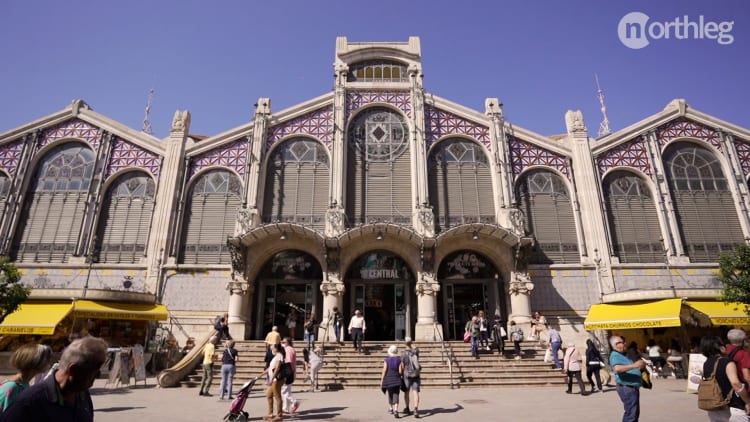
It is a building that embodies and encapsulates Valencia’s craftsmanship, agricultural heritage and artistic traditions. The glass domes and windows, the iron frame and colourful tiles offer amazing photo opportunities.

Aside from its historical and architectural value, the market also gives you a chance to experience a snippet of Valencian life. Just like a local, you’ll get to stroll among fresh fruit and vegetable stands, stopping here and there to try local wines and products. When the time for luch approaches, you can enjoy a variety of freshly made tapas and Valencian flavours.
Iglesia de San Nicolás
The Iglesia de San Nicolás de Bari y San Pedro Mártir, also simply known as Saint Nicholas Church, is the second most visited religious building in Valencia. Its fame is due to its unique combination of Gothic and Baroque styles, as well as its spectacular ceiling frescoes.

Even the non-religious types can’t help but be completely captured by this last feature, which has earned the church its nickname Sistine Chapel of Spain.
All over the church, especially in the frescoes, you’ll realise there are several references to the lives of the two saints that give their names to the church - Saint Nicholas and Saint Peter Martyr.
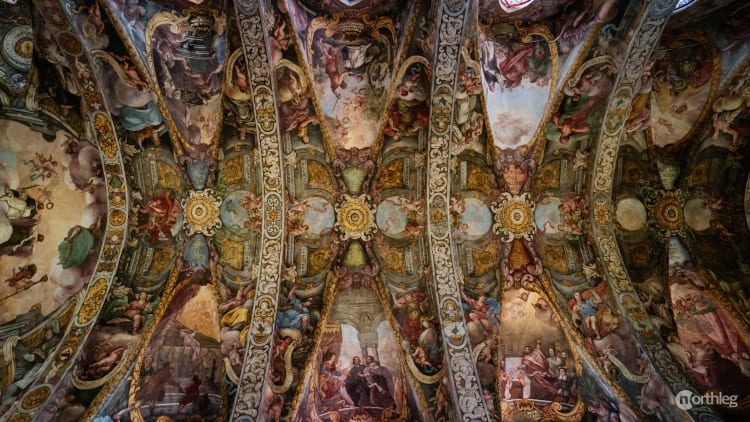
Some of the stories are exactly what you would expect from a saint - healing, preaching, etc. Others, instead, are extremely gruesome and grotesque. See if you can find the plate of (human!) meat on your visit to the church.
Plaza del Ayuntamiento
Plaza del Ayuntamiento or Plaça de l’Ajuntament in Valencian, is the City Hall square in Valencia. As such, it is one of the most important and central squares of the city, a meeting point for many Valencians of all ages.

The main decoration in the square comes from the trees, the round fountain, and the surrounding architecture. The most noticeable and beautiful constructions are the Town Hall building, the Correos building, and the Flower Market.
The site is a hive of activity. On a normal day, locals can be found relaxing by its fountain and enjoying the view. During Fallas, the square becomes one of the city’s most eventful spots, and even at other times of the year, chances are that you’ll see a parade, a concert, a speech, a pop-up market, or some kind of show in the square.
If you don’t pass by Plaza del Ayuntamiento on your visit to Valencia, it means you haven’t walked around enough.
Valencia’s Beaches
The beaches are one of Valencia’s prides. The sand is kept clean and their size and spaciousness make it so that they never feel crowded, even in high season. There are four of them off the city’s coast: the closest ones Platja del Cabanyal, Playa de la Malvarrosa, Playa de Les Arenas and the slightly further away one, Playa Patacona.

The beach and sea are perfect for when you need a little break from the city (and you’ll probably need one at some point). Spaniards often travel to Valencia for its beaches and sea, so there’s plenty of activities you can do.

You simply walk the long promenade and enjoy the sea breeze or you can play beach sports or water sports. Or maybe you just want to relax, perhaps sunbathing and reading a book or sipping on a cocktail at one of the numerous beach bars.
Instituto Valenciano de Arte Moderno
This one is an essential for all art and contemporary culture lovers. The Instituto Valenciano de Arte Moderno (IVAM) is a modern and contemporary art museum in Valencia’s city centre.

It has a permanent collection of about 12,000 works by both Spanish and international artists, but the majority of the rooms host temporary exhibitions, conferences and artistic events.
In a sense, when you visit, you’re seeing something that is never going to be the same again. Here, you can learn and reflect on the ideas that have shaped and continue to shape artistic discourses.

The museum is always presenting unexpected and challenging ideas in a fascinating way, so we would recommend it even for those who don’t consider themselves art aficionados or experts.
Museum personnel are present in every room, and will be happy to explain concepts and contexts behind the exhibitions in an understandable and, most importantly, compelling way (and this we can tell you from personal experience).







